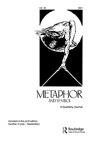基督教象征中隐喻与转喻的相互作用
IF 3.3
3区 文学
0 LANGUAGE & LINGUISTICS
引用次数: 2
摘要
宗教符号通常被视为神秘的,甚至是神奇的,连接可见和不可见世界的纽带。它们也存在于基督教的本质中:它们存在于它的语言、礼拜仪式以及各种形式的宗教艺术中。一方面,从认知语言学的角度来看,宗教符号具有转喻的性质。然而,在本文中,我们认为基督教的符号实际上是更复杂的概念,因为它们往往基于隐喻,隐喻和转喻之间的相互作用。因此,在我们的定性研究中,我们分析了一些基督教符号的例子,这些符号植根于圣经语言,直接或间接地与基督本人有关,以呈现激发其意义的隐喻类型。隐喻-转喻相互作用的模式包括隐喻源域或隐喻目标域的转喻扩展或缩减。通过这种方式,我们旨在表明,尽管宗教符号被赋予了特殊的角色,但由于隐喻-转喻相互作用理论,它们的神秘本质和意义的复杂性可以被成功地解开。本文章由计算机程序翻译,如有差异,请以英文原文为准。
The Interplay of Metaphor and Metonymy in Christian Symbols
ABSTRACT Religious symbols are often treated as mysterious, and even magical, links between the visible and the invisible worlds. They also lie in the nature of Christianity: they are present in its language, liturgy, as well as various forms of religious art. On the one hand, taking the cognitive-linguistic standpoint, it can be claimed that religious symbols are metonymical in nature. However, in this paper, we argue that Christian symbols are, in fact, more complex conceptually, as they are often based on metaphtonymy, an interaction between metaphor and metonymy. Thus, in our qualitative study, we analyze selected examples of Christian symbols rooted in the biblical language and related directly or indirectly to the person of Christ in order to present the types of metaphtonymy motivating their meaning. The identified patterns of metaphor-metonymy interaction include metonymical expansion or reduction of either the metaphorical source or target domain. In this way we aim to show that despite the special role ascribed to religious symbols, thanks to the theory of metaphor-metonymy interaction their mysterious nature and complexities of meaning can be successfully untangled.
求助全文
通过发布文献求助,成功后即可免费获取论文全文。
去求助
来源期刊

Metaphor and Symbol
Multiple-
CiteScore
2.90
自引率
0.00%
发文量
23
期刊介绍:
Metaphor and Symbol: A Quarterly Journal is an innovative, multidisciplinary journal dedicated to the study of metaphor and other figurative devices in language (e.g., metonymy, irony) and other expressive forms (e.g., gesture and bodily actions, artworks, music, multimodal media). The journal is interested in original, empirical, and theoretical research that incorporates psychological experimental studies, linguistic and corpus linguistic studies, cross-cultural/linguistic comparisons, computational modeling, philosophical analyzes, and literary/artistic interpretations. A common theme connecting published work in the journal is the examination of the interface of figurative language and expression with cognitive, bodily, and cultural experience; hence, the journal''s international editorial board is composed of scholars and experts in the fields of psychology, linguistics, philosophy, computer science, literature, and media studies.
 求助内容:
求助内容: 应助结果提醒方式:
应助结果提醒方式:


